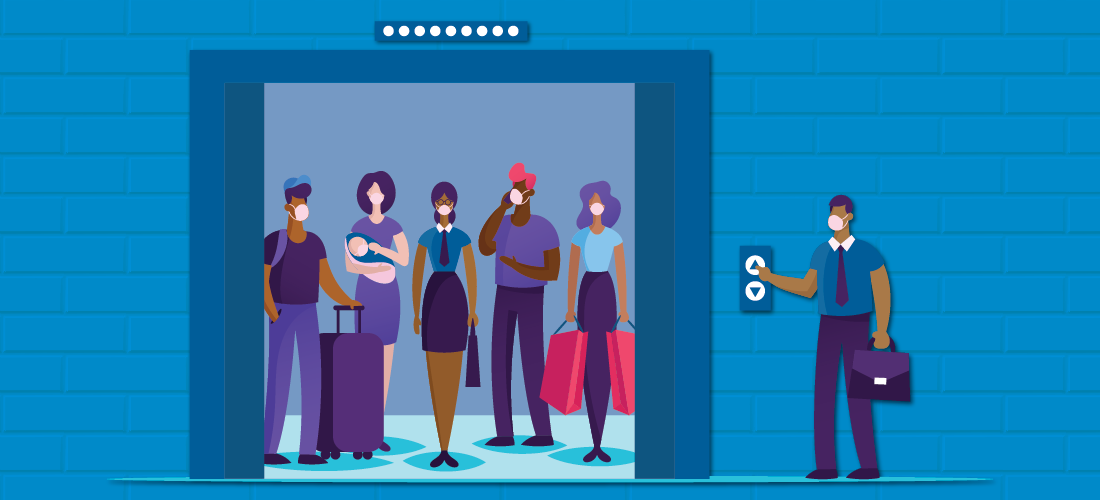The past few months have sent the world into a tailspin. Professionally and personally, we’ve had to hit pause on almost everything. We’ve had to reflect and evaluate the way we behave and work to ensure our actions consider the health, safety, and equity of others. No person or business has been immune to the chaos. And while the big online retail brands, grocery retailers, and QSRs have weathered this unprecedented time best, not all businesses in the retail and hospitality industry have faired as well.
Retail brands typically pride themselves on knowing their customers through robust voice of customer (VOC) channels and data gathered from marketing and customer insights. Then, COVID-19 hit. Currently, every city and state has different rules and guidelines regarding in-store and curbside shopping. Adding to this confusion, customers have their own personal views on which activities they’re comfortable taking part in, including whether they will wear a mask in a store or restaurant. (Depending on your location’s policy, your front-line workers may have to approach customers and ask them to put on a mask, which can feel awkward and uncomfortable. We’ll have tips to share to help front-line workers manage these sorts of scenarios soon.) With so many variables, the customer experience (CX) delivered by each store is different, making it difficult, if not impossible, for national retailers to define and then execute a standard brand CX.
Additionally, customers are leveraging new channels to share their experiences, like the popular social media network, Nextdoor. Typically reserved to share recommendation on local gardeners, community events, and activities, Nextdoor has emerged as a source of retail intel, too. People are using the network to share opinions on which grocery stores require masks, which market has long lines, which restaurants are offering delivery, their interactions with employees, and much more. Brands are seeing that their go-to sources for customer voice data change often and new sources are being added regularly, especially in the social media arena. Leaders need to continually look for the new channels emerging and determine the best ways to listen, respond to, and engage with customers on those channels.
Three Tips for Business Survival: How to Create Lasting Brand Fans
The world isn’t going to stop changing. It’s unclear when things will “normalize.” It’s also unclear what “normal” will even mean moving forward. What is your business doing to pivot and adjust your strategy to meet customers where they are today? What are you doing to develop the agility to adjust to meet them where they are next week? If you’re struggling with the current state and are feeling unsure about how to prepare for the future, here are three tips to consider.
TIP 1: Leaders must be aligned and act with an agile mindset.
Brands that see the need to change and have leaders who have already adopted an agile mindset will be able to weather issues best. For example, an article from Refinitiv, which reports on financial markets data, states that Best Buy’s Q1 sales grew 154.4% over the past year – thanks, in part, to launching curbside pickup orders well before other large, long-standing retailers. It takes alignment at the top and agile teams to innovate and execute so quickly on behalf of rapidly changing customer needs. These numbers demonstrate how this brand successfully addressed the challenges of COVID-19 and adopted new practices that worked for their customers.
Not all brands have fared so well. The article states that 41% of brands (of the 74% of companies in Refinitiv’s Retail/Restaurant Index who have reported Q1 2020 EPS) reported earnings below analyst expectations. We have a few observations on why some performed better than others:
- Retailers have been hit hard because customers simply couldn’t shop in store. Some brands quickly amplified the customer experience by opening up other purchasing channels, such as curbside pickup, or by creating new virtual customer experiences through video-chat shopping. Other retailers leveraged Instagram to stay connected to their customer base and offer new ways to help them through these tough times. This type of agile response to changing customer expectations will continue to set some retailers apart from the rest.
- The restaurant industry has also been massively impacted by the closure of in-restaurant dining. Those that adjusted quickly to contactless delivery and take-out options kept old customers and also attracted new ones. Additionally, some restaurants saw a new opportunity to serve customers by selling pantry staples, groceries, and meal kits. This shift created a new revenue stream to help offset the lost sales and higher costs associated with operational changes.
What made these quick pivots possible? Brand leaders aligned around a shared goal to provide a differentiated, consistent experience that delivered on new customer expectations. Speed was key, because none of us could have predicted in January that we’d face two or three months of very limited in-person sales or dining.
Leaders who were already united in their mission were able to work together quickly to make necessary adjustments when the crisis struck. This alignment quickly moved out of the C-suite to the front-line managers and teams, ensuring they also had shared meaning around the “why,” “what,” and “how” of the new customer experience and their role in delivering it. When leadership works in unison and shows agility in fast strategy adjustments, it sends a loud and clear message throughout the company and builds (or rebuilds) customer confidence.
TIP 2: Listen to (and think like) the customer; then pivot and change.
Front-line employees often know the voice of their customers better than leaders in the C-suite. They need to be empowered and trusted to pivot in the moment to make the CX they deliver better. Addressing issues in real time is paramount to helping brands survive. Leaders need to pay attention to the actions and behaviors the front line is using to serve customers and must consider what best practices should be scaled across all locations.
A local McDonald’s drive-thru we visit made a smart change during the early stage of the pandemic – they put their credit card machine on a stick. Instead of the standard practice of handing your credit card to the cashier, the cashier now extends the credit card machine out the window to you, and you run your card yourself, eliminating the need for contact at the point of purchase. Since we haven’t seen this practice employed at other McDonald’s locations, we believe this was a decision made by the local franchisee or unit manager, and we applaud it. It’s an example of agility at the local level, and it’s these types of front-line decisions that will keep a store in business.
Strategic decisions might be made from the top, but it’s essential to get insight from the front line and local teams in the field. Two-way communication is often illuminating, as the best practices for your business could be ones you’re not even aware of. Engaging your front line gives them a voice and a role in the solution, motivating them to adopt change and stay the course. What are you doing to collect this knowledge?
TIP 3: The time is now to adopt new technologies and to convert your employees into champions for the technology with your customers.
The hotel industry is working hard to adjust to the pandemic, creating new standards and policies for cleaning, contactless check-ins, and expanded use of mobile room keys. Taking a cue from the airline industry’s mobile boarding passes, mobile room keys allow hotel guests to unlock their hotel rooms via their phones. Sounds simple, right? Unfortunately, many customers have experienced a less-than-seamless experience, often late at night when their room is far from the lobby. When the customer cannot get the key to work, it creates a problem for both the customer and the employee who has to assist them, which is why the guest is often offered a physical back-up key just in case. This lack of confidence in the technology, coupled with a fear that this will remove the need for the employee’s job, means the employee often avoids or even undermines the strategy. This creates a problem during a pandemic, when contactless check-in is a must. Employees, leaders, and owners need to get on board – and quickly.
Restaurants can’t avoid the use of technology any longer, either. Those that hadn’t been using online reservations or wait systems must do so now to avoid having patrons gathering by the host’s stand. Those that had previously not offered online or app ordering need to get up to speed. Retailers, too, need better tech to make curbside pick-ups seamless. Contactless check-out/bill pay may be the biggest must of all, as it impacts every single transaction.
In all of these situations, employees are involved in the make-or-break moment of technology adoption. They have to adopt technology quickly, build confidence in the new system, and advocate its use with customers. The best way we’ve seen to accomplish this quickly is to give them the “why” behind the change (don’t assume they automatically know its impact on your business and on the customer). Then, give them time to practice and use the technology before they interact with customers. Perhaps most critical is to hear them when they share feedback about their and their customers’ use of the technology. Engage them often in how to fix problems quickly.
The Way We Shop, Sleep, and Eat Has Been Disrupted: Have You Pivoted Yet?
COVID-19 has required us to change the way we work, socialize, shop, and so much more. What are you doing to show your people and your customers that you care? What are you doing to listen and pivot?
Retail brands can survive this crisis and set themselves up to survive the next unknown by getting leaders aligned, getting employees ready and on board for the new journey, and connecting with customers so they know you care and they can count on you. Above all, retailers must adopt a change mindset.
Want to discuss how you can build the right change strategy for your unique business? We’re ready to talk when you are.









